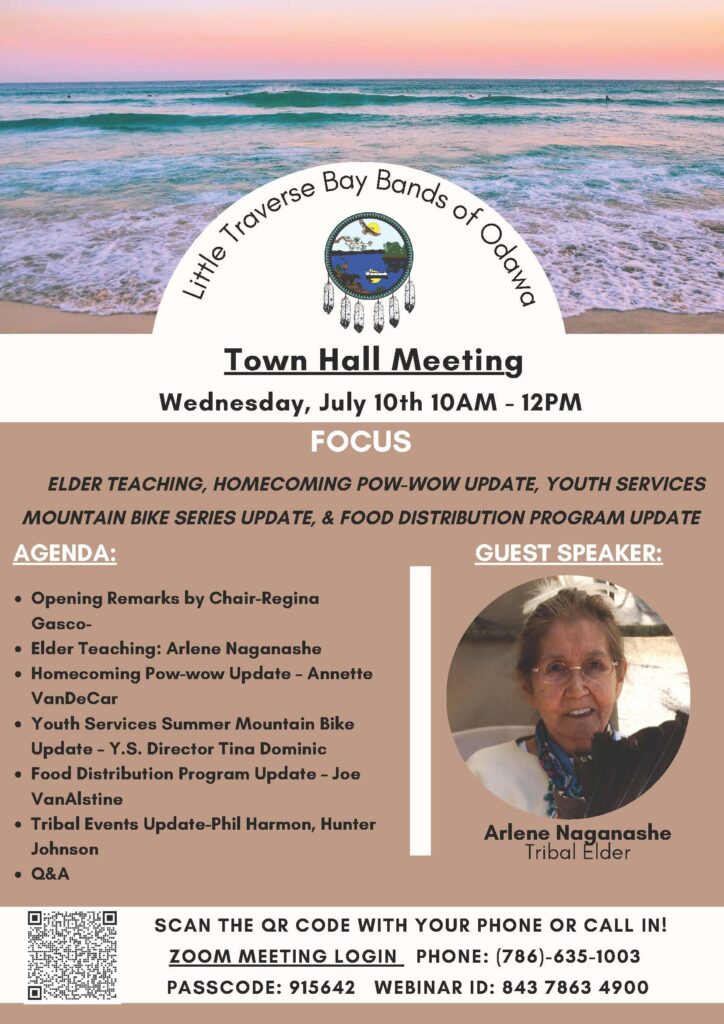General Election: June 28, 2021 Candidates for Tribal Council
RICKY COMPO
TAMARA KIOGIMA
LEROY SHOMIN
DOUG EMERY
WILLIAM ORTIZ
MARCI REYES
KENNETH DEWEY
AARON OTTO
SHARON SIERZPUTOWSKI
SIERRA BODA (WITHDREW 5-14-21)
Northern Michigan enjoys many lakes, rivers, wetlands, and springs in which to play, boat, fish, swim, hunt, gather, and drink. Overall, the water quality appears nearly pristine (although less well-known contaminants are already in our waters). To keep it that way, we must be on the lookout for nonpoint source pollution. Nonpoint source pollution comes from many diffuse sources (not straight from a pipe to a waterbody) and is caused by rainfall or snowmelt moving over through the ground which has contaminants on it. Some examples of nonpoint source pollution are stormwater runoff and undersized or failing road-stream crossings. Stormwater runoff usually occurs when rainwater passes over an impermeable surface of an urban area and into storm drains (which goes to the nearest water body), however, during this process, it can pick up many contaminants, such as oil, gas, and trash.
Poor road-stream crossings occur when culverts are not sized properly according to stream width and flow. Poor crossings can create upstream ponds, where water gets backed up above the culvert; scour pools, where fast-flowing water creates a deep pool coming out of the culvert; erosion, from soil being washed away from areas of fast flowing water and near the culvert; and perched culverts; when the downstream side of the culvert is above the water’s surface. Other examples include, excess fertilizer runoff from agricultural fields, soap in runoff from washing a car, and soil erosion from a recently harvested forest on a hillside. Nonpoint source pollution creates problems, such as beach closures (when animal fecal matter enters the water causing bacteria to outbreak), decreased fish spawning habitat (due to sediment entering the streams), and increased lake and river temperatures that are too warm for fish.
LTBB is beginning to address these issues through a nonpoint source assessment and management plan. We’ve identified nonpoint source issues with our surface water quality data, State of Michigan data, and local watershed plans. We’ve met with groups, such as Conservation Resource Alliance, Tip of the Mitt Watershed Council, Emmet County Road Commission, Walloon Lake Trust and Conservancy, Little Traverse Bay Watershed Committee, and Lake Charlevoix Watershed Committee to outline how to manage nonpoint source issues. In addition, LTBB started conducting road-stream crossing inventories in 2018, like many local partners, in an attempt to identify and monitor road-stream crossings that may cause fish passage issues and erosion.
Many emerging contaminants are also entering our waterways through nonpoint source pollution. Pharmaceuticals and personal care products enter our waterways in the effluent of wastewater treatment plants, runoff from agricultural fields (when fertilized with sewage and manure), and from leaking septic systems. These chemicals are known to cause damage to aquatic organisms at very small concentration levels. For example, acetaminophen can negatively impact Rainbow Trout at concentrations as low as 10 ppb. However, the impacts to the whole populations, communities, and ecosystems are not well known. Local research completed in 2018, found DEET (active ingredient in bug spray), triclosan (antifungal/antibacterial in soaps, toothpastes, etc) and caffeine in Emmet and Cheboygan Counties’ lakes and rivers. Shockingly, some lakes and rivers had concentrations far over national median values. More research and monitoring needs to be completed to identify impacts on aquatic and terrestrial ecosystems, which can then be used to hinder more pharmaceuticals and personal care products from entering our waterways. In the next few years, LTBB hopes to start monitoring pharmaceuticals and personal care products in our local waters.
LTBB received authority to administer our Clean Water Act Section 319 program from the Environmental Protection Agency on October 10, 2017. The new program will provide us with base funding for salaries, education, and small projects. We will also have access to a national competitive grant for larger nonpoint source issues. We are looking forward to helping restore and protect resources in Northern Michigan. We plan to support and seek the help of our many partners and collaborators.
RICKY COMPO
TAMARA KIOGIMA
LEROY SHOMIN
DOUG EMERY
WILLIAM ORTIZ
MARCI REYES
KENNETH DEWEY
AARON OTTO
SHARON SIERZPUTOWSKI
SIERRA BODA (WITHDREW 5-14-21)
BERNADECE (BERNIE) BODA & LINDA GOKEE
REGINA GASCO-BENTLEY & STELLA KAY
(Click Team To Read Their Statements)
BERNADECE (BERNIE) BODA & LINDA GOKEE
REGINA GASCO-BENTLEY & STELLA KAY
(Click Candidate Name To View Their Statement)
Search Code Index
function search(string){ window.find(string); }
LTBB Events
Sun Mon Tue Wed Thu Fri Sat 

Contact SPRING
[ninja_form id=12]
https://app.hellosign.com/s/LJki90VA